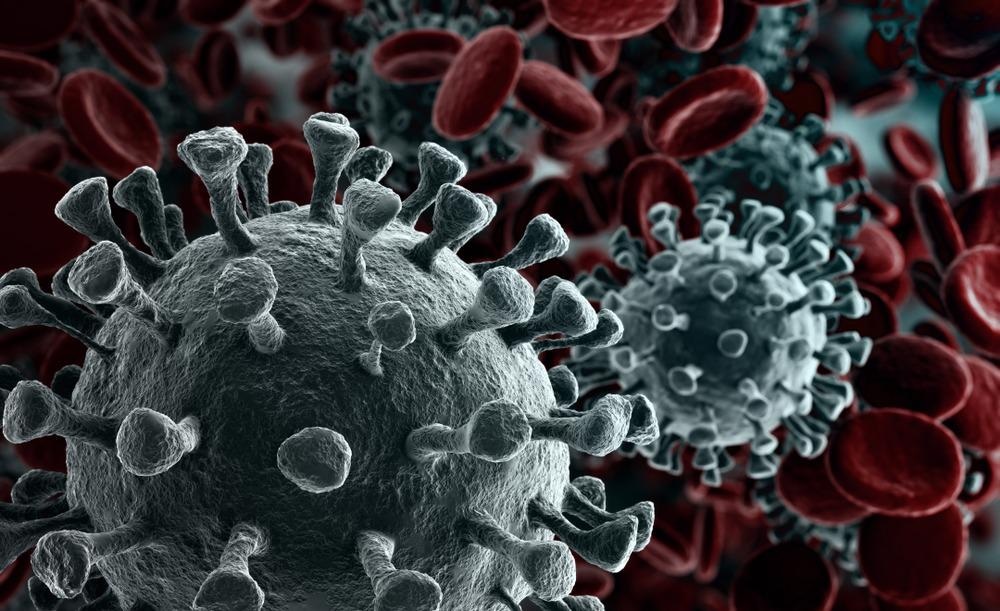
Image Credit: creativeneko/Shutterstock.com
The ongoing coronavirus pandemic results from one of the deadliest infections this generation has seen: SARS-CoV-2. The situation has overwhelmed healthcare institutions worldwide and highlighted the need for high-throughput virus sensing methods to assist in the rapid and early diagnosis of the virus and associated diseases.
Early identification is central to controlling the pandemic, and vibrational optical spectroscopy techniques such as Raman spectroscopy could be key. The method provides results in real-time and is non-destructive, non-invasive, and highly specific.
Raman Spectroscopy Explained
When light hits a sample, it is scattered in different directions and mostly exhibits the same wavelength as the original light. However, sometimes the light is inelastically scattered. This means the incident light turns energy to molecular vibration and exchanges energy with the sample, changing the light wavelength.
Raman spectroscopy analyzes the interactions between the sample and the light to reveal the material’s “chemical fingerprint”, which can be used to identify or characterize the substance.
Fighting COVID with Raman Spectroscopy
COVID-19 is an airborne infection transmitted via direct routes - coughing, sneezing, and subsequent droplet inhalation - or by touching nasal, oral, and eye mucous membranes, i.e., contact routes. The virus is proven to be present in human biofluids – blood and saliva, and possibly sputum, tears, and wound secretions.
These biofluids contain biomarkers, specific signs such as proteins, nucleic acids, lipids, carbohydrates or hormones, that show the infection is present.
COVID-19’s biomarkers are a single strand of positive-sense RNA and the S protein that binds to the host cell-membrane receptor to allow it into cells. The biomarkers can be detected by molecular specific tests such as Raman spectroscopy.
The technique is already used to detect HIV and Dengue Fever. Therefore, scientists hypothesize that it could also be used to analyze biofluid samples from those potentially infected with COVID-19.
Advantages of Raman Spectroscopy Over Other Methods
There are several diagnostic protocols for COVID-19, but each has limitations, such as false positives or false negatives.
The current gold standard test is the real-time reverse transcriptase-polymerase chain reaction (RT-PCR).
RT-PCR searches for the virus’s genetic material – the RNA – in a sample taken from the patient’s nose and throat. However, it is an expensive, complex, and time-consuming method. It also involves pre-processing samples; the small amount of material in the sample must be replicated using enzymes and labeled with primers or probes.
What is needed is a sensitive, inexpensive test for mass screening. The ideal test would be accurate for COVID-19 and future virus variants that may emerge. Raman spectroscopy could fit the bill; it exhibits strong molecular specificity making it suitable for biochemical profiling of cells in biofluids and cell cultures, and only requires a small sample size.
The technique requires minimal sample preparation and is easily scalable. Once applied on a large scale, costs will decrease, meaning it can be extended to low-resource settings. Furthermore, the data can show results in a color-coded system for healthy, dubious, and diseased cases, helping speed up testing.
A technique based on Surface Enhanced Raman Spectroscopy - a surface-sensitive method that enhances scattering using metallic nanostructures' plasmonic properties – shows great promise, particularly when coupled with microfluidic devices containing integrated microchannels functionalized with gold or silver-coated carbon nanotubes.
The devices trap virus particles found in biofluids based on their size and identify them using their Raman signatures. Early in the disease, when the level of biomarkers is low, their proximity to the metallic nanostructures enhances the scattering of particles; a single molecule could even be detected, claim scientists, thanks to the test’s high selectivity and sensitivity.
Scientists believe this technique could be used to screen symptomatic and asymptomatic individuals who could be potential spreaders of the infection. However, the method still needs further tests to develop specificity and sensitivity against RT-PCR.
A second test developed by researchers at Northern Arizona University uses a variation of SERS – Single Molecule-SERS or SM-SERS. The method has been used to detect markers associated with breast cancer. Scientists believe it could be adapted to detect the S protein on the virus molecule, which is involved in the infection at a cellular level.
Scientists say this test would also tick many of the boxes required of a practical alternative test: it is inexpensive, fast, highly selective, and has high specificity. Furthermore, its portability would allow it to be used in remote and hard-to-reach areas or point-of-care stations in schools, factories, and community centers.
Conclusion
The unprecedented situation created by the coronavirus pandemic has demonstrated the need for new diagnostic tests that quickly and easily screen symptomatic and asymptomatic patients while detecting new variants of the same infection. Raman spectroscopy, and variations based on this method, could meet all the requirements needed of an alternative test to help fight against the fatal viruses experienced this century.
References and Further Reading
Carvalho LFDCES et al. (2020) Optical techniques for fast screening - Towards prevention of the coronavirus COVID-19 outbreak Photodiagnosis Photodyn Therapy 2020;30:101765. doi:10.1016/j.pdpdt.2020.101765 [Online] https://www.ncbi.nlm.nih.gov/pmc/articles/PMC7158832/ Accessed 15th January 2021.
Desai S. et al. (2020) Raman spectroscopy‐based detection of RNA viruses in saliva: A preliminary report Journal of Biophotonics [Online] https://onlinelibrary.wiley.com/doi/10.1002/jbio.202000189 Accessed 15th January 2021.
Jadhav. S et al. (2021) Development of integrated microfluidic platform coupled with Surface-enhanced Raman Spectroscopy for diagnosis of COVID-19 Medical Hypotheses [Online] https://www.sciencedirect.com/science/article/abs/pii/S0306987720332473 Accessed 15th January 2021.
Photonics Media (2020) Scientists Apply Raman Spectroscopy to COVID-19 Testing, photonics.com [Online] https://www.photonics.com/Articles/Scientists_Apply_Raman_Spectroscopy_to_COVID-19/a65791 Accessed 15th January 2021.
Panjwani A. (2020) How does a Covid-19 test work? Full Fact [Online] https://fullfact.org/health/coronavirus-pcr-test-accuracy/ Accessed 15th January 2021.
Disclaimer: The views expressed here are those of the author expressed in their private capacity and do not necessarily represent the views of AZoM.com Limited T/A AZoNetwork the owner and operator of this website. This disclaimer forms part of the Terms and conditions of use of this website.